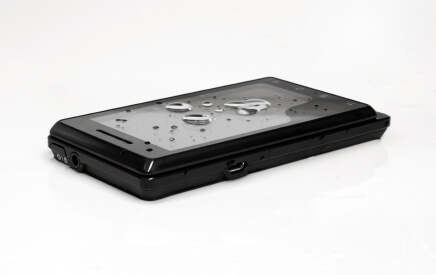TRUSTED EXPERTS
ANY DEVICE
Do’s and Don’t to Prevent SmartPhone Data Loss if Your Phone Gets Wet

Whether you dropped your phone in a puddle (or a toilet), or you’re an East Coast resident whose smartphone was damaged in Hurricane Sandy (or during the extensive relief and recovery efforts that followed), water damage is one of the worst — and most common — things that can happen to your phone.
Fortunately, water damage to your smartphone doesn’t always mean your data is gone forever and your phone is a lost cause. Most SSD and flash memory used in phones are waterproof. It’s the other components that are susceptible to water damage.
Sometimes, simply drying out your phone will fix any temporary damage. Other times, drying out the phone will permit you to turn it on long enough to retrieve your data and sync it to your computer, iTunes, or even transfer it to a new smartphone.
Follow these steps to maximize the odds that you’ll be able to retrieve your important data and maybe even save your smartphone.
1 – Turn off the phone, and keep it off. Do this first to prevent further damage. Remove the battery.
2 – With a towel, paper towel or even your shirt, dry off the phone as best you can.
3 – Fill a zip-closure storage bag or a plastic, sealable storage container with uncooked rice. Bury your phone in the rice and seal the container.
4 – Keep the phone in a warm, but not hot, area, for at least 24 hours or longer (if your phone was splashed with water, 24 hours should suffice; if it was completely submerged, you may want to store it for two days).
5 – Finally, remove the phone from the container, put the battery in and attempt to power it on. Now is the time to back up your data. Your phone might last for several more years or months, but it could show signs of damage after just a short time.
6 – If your phone still isn’t working, a professional data recovery service may be able to recover your smartphone data. Call us immediately to get a free estimate within 24 hours.
Always remember to perform regular back-ups of your important apps, documents, photos and contacts, to prevent data loss if your phone is damaged.
Drying out data storage devices is not recommended for conventional hard disk drives, only for devices like smartphones, which use solid state memory. You can find out how to improve the odds of a successful data recovery for a RAID array or conventional hard disk drive here.
Start A Recovery
Get Started Below
Error: Contact form not found.
![]() WOW... fantastic customer experience! Submitted a totally dead 1TB drive for recovery yesterday now its fully recovered before noon the next day! Exceptional customer service, and impeccable reputation. Thank you 24 Hour Data, ever so much for getting my valuable data recovered and back to me. Very reasonable rates. My hat goes off to the BEST data recovery service in Dallas or in the country for that matter! You will not be disappointed using their services....
WOW... fantastic customer experience! Submitted a totally dead 1TB drive for recovery yesterday now its fully recovered before noon the next day! Exceptional customer service, and impeccable reputation. Thank you 24 Hour Data, ever so much for getting my valuable data recovered and back to me. Very reasonable rates. My hat goes off to the BEST data recovery service in Dallas or in the country for that matter! You will not be disappointed using their services....
Mark Davis
Bear Technologies











